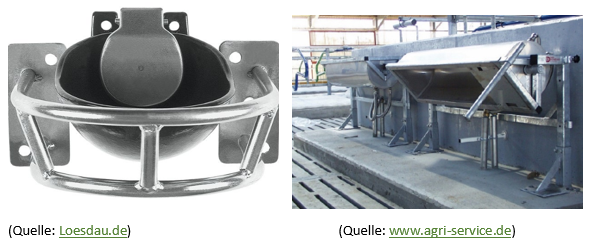Water is one of the most important, if not the most important, feed. Yet there are only few, if any, binding requirements for water supply. The water requirement is highly intertwined with the animal's performance and feeding. Animals that drink too little also eat too little!
Factors that influence water intake include the animal:drinker ratio, the arrangement of the drinkers and the contamination of the drinkers and the drinking water. To ensure that lower-ranking animals can drink sufficiently and undisturbed, there should be at least 2 drinkers per group, regardless of the group size. In addition, the animal:drinker ratio for individual drinkers (so-called bowl drinkers) should not be higher than 8:1.
Cattle prefer open water surfaces, but these can easily be soiled by faeces. Nipple drinkers are not an alternative to avoid this! They do not accommodate the animals' natural drinking behaviour and "playing around" with the nipples increases water consumption, increases the amount of slurry and makes the drinking area wet and slippery or muddy. Shallow trough drinkers, at which several animals can drink at the same time, are well suited for suckler cow husbandry. A water depth of 10 cm is sufficient, but the flow rate is more important. If this is less than 40 litres/minute, deeper drinkers are recommended to meet the needs of the cows.
In order to be able to offer a drinking trough that meets the animal's needs with an appealing water quality, it is therefore important to protect the drinking troughs from getting soiled by faeces. For bowl drinkers there are deflectors for this purpose (see picture). However, as these deflectors are only a short distance away from the drinking trough, soiling of the bowldrinker can often be observed. In dairy farming, large drinking troughs with corresponding amounts of water are used; another advantage is that these troughs are easy and quick to clean. The basins are often placed on platforms (see picture).
 To drink, the cow can step onto the platform with her front legs to reach the drinking trough, a position that cows naturally like to adopt. However, as long as the platform is not too big, they cannot "park" backwards to defecate in the drinker. Climbing backwards onto a step is not a behaviour that suits a cow. So appropriately designed platforms under the drinking trough provide effective protection from soiling. Unfortunately, this method will not be very suitable for fattening bulls, as there is more rank fighting in these animals and a fall onto an edge could have serious consequences.
To drink, the cow can step onto the platform with her front legs to reach the drinking trough, a position that cows naturally like to adopt. However, as long as the platform is not too big, they cannot "park" backwards to defecate in the drinker. Climbing backwards onto a step is not a behaviour that suits a cow. So appropriately designed platforms under the drinking trough provide effective protection from soiling. Unfortunately, this method will not be very suitable for fattening bulls, as there is more rank fighting in these animals and a fall onto an edge could have serious consequences.
Literature:
- Herrmann, H.-J., DLG-Ausschuss für Technik in der tierischen Produktion (2014): DLG-Merkblatt 339: Wasserversorgung für Rinder. Bauliche, technische und bedarfsgerechte Lösungen https://www.dlg.org/fileadmin/downloads/landwirtschaft/themen/publikationen/merkblaetter/dlg-merkblatt_399.pdf
- Ministry for Food Agriculture and Consumer Protection of Lower Saxony. Tierschutzleitlinie für die Mastrinderhaltung. Hanover: Ministry for Food, Agriculture and Consumer Protection of Lower Saxony (2018). https://www.laves.niedersachsen.de/download/139604/Tierschutzleitlinie_fuer_die_Mastrinderhaltung.pdf
This innovation has an impact on:
- Animal health and welfare: An optimal water supply contributes to animal health and welfare.
- Production efficiency and meat quality: Animals that drink more, eat more and are thus more productive.